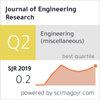电子束辐照对废水中雌激素去除的影响
IF 0.9
4区 工程技术
Q3 ENGINEERING, MULTIDISCIPLINARY
引用次数: 0
摘要
为了有效地去除废水中的微污染物,如雌激素,通常建议对传统的废水处理厂(WWTP)进行改造,采用高级氧化工艺(AOP)进行后处理。研究了电子束吸收剂量对生物处理废水中雌激素去除的影响。将已知浓度的E1, E2, E3和EE2(0.2, 0.5, 5.0和10µg/l)加入到从城市污水厂获得的样品中,然后用0.2,2.0,5.0和10.0 kGy的EB剂量照射。采用液相色谱-质谱法(LC-MS)分析辐照后雌激素水平。根据所获得的结果,雌激素浓度随着吸收剂量的增加而稳定下降,直至2 kGy。然而,当EB剂量超过2 kGy时,雌激素去除量没有显著增加。据估计,不同类型雌激素的去除率在86%到99%之间。E2是降解最快的雌激素,其次是E3、EE2和E1。本文章由计算机程序翻译,如有差异,请以英文原文为准。
Effect of electron beam irradiation on estrogens removal from treated wastewater
In order to remove micro pollutants such as estrogens efficiently from wastewater, it is often recommended that conventional wastewater treatment plants (WWTP) be retrofitted with an advanced oxidation process (AOP) for post-treatment purposes. This study examined the effects of electron beam (EB) absorbed dose on the removal of estrogens from biologically treated wastewater. Known concentrations of E1, E2, E3 and EE2 (0.2, 0.5, 5.0 and 10 µg/l) were spiked into samples obtained from a municipal wastewater plant, which were then irradiated with EB doses of 0.2, 2.0, 5.0 and 10.0 kGy. Levels of estrogen after irradiation were analyzed using the liquid-chromatography mass-spectrometry (LC-MS). According to the results obtained, the concentration of estrogens decreased steadily with an increasing absorbed dose up to 2 kGy. However, there was no significant increase in estrogen removal at EB doses above 2 kGy. It is estimated that the removals of the different types of estrogen are ranged from 86 % to 99 %. E2 was found to be the fastest estrogen to be degraded, followed by E3, EE2, and E1.
求助全文
通过发布文献求助,成功后即可免费获取论文全文。
去求助
来源期刊

Journal of Engineering Research
ENGINEERING, MULTIDISCIPLINARY-
CiteScore
1.60
自引率
10.00%
发文量
181
审稿时长
20 weeks
期刊介绍:
Journal of Engineering Research (JER) is a international, peer reviewed journal which publishes full length original research papers, reviews, case studies related to all areas of Engineering such as: Civil, Mechanical, Industrial, Electrical, Computer, Chemical, Petroleum, Aerospace, Architectural, Biomedical, Coastal, Environmental, Marine & Ocean, Metallurgical & Materials, software, Surveying, Systems and Manufacturing Engineering. In particular, JER focuses on innovative approaches and methods that contribute to solving the environmental and manufacturing problems, which exist primarily in the Arabian Gulf region and the Middle East countries. Kuwait University used to publish the Journal "Kuwait Journal of Science and Engineering" (ISSN: 1024-8684), which included Science and Engineering articles since 1974. In 2011 the decision was taken to split KJSE into two independent Journals - "Journal of Engineering Research "(JER) and "Kuwait Journal of Science" (KJS).
 求助内容:
求助内容: 应助结果提醒方式:
应助结果提醒方式:


